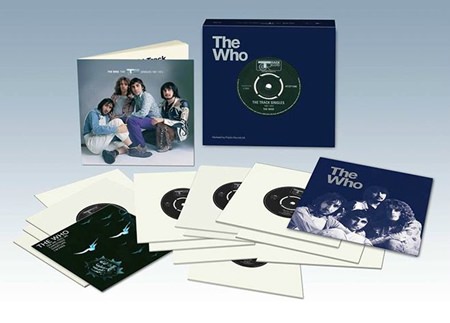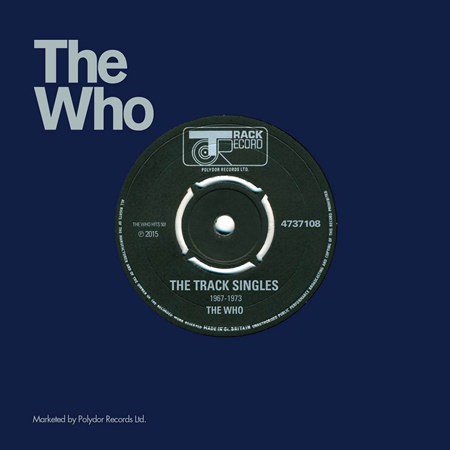
The Who, The Track Singles 1967-1973 (Track/Universal)
Released: October 2015
“The Track Singles 1967-1973”-box is part 3 in a lovely series of the original British Who 45’s, re-issued in replicas of their original sleeves (for the Track-singles part plain white factory sleeves – with two exceptions).
Please Support Pattaya Mail
In last week’s column we got half way through the box. This week we focus on the second part: 1970-1973. During this period they released three of rock’s greatest albums of all time: “Live At Leeds”, “Who’s Next” and “Quadrophenia”. And even if Pete Townshend lost his enthusiasm for the single format back in 1967 when “I Can See For Miles” bombed (see last weeks’ column), he still managed to work up enough passion to record and release a string of fabulous 45’s too. All on Track Records. All of them included in this box. (Number after release date denotes highest placing on New Musical Express’ UK TOP 30, except from numbers in brackets which are from Record Retailer.)
“The Seeker” / “Here For More” (March 1970) #17
Searching for the meaning of life John Lennon would renounce all gurus including Dylan and the Beatles in the song “God” on his “John Lennon/Plastic Ono Band”-album at the end of 1970. Pete Townshend beat him to it with “The Seeker”, released nine months earlier:
I asked Bobby Dylan
I asked The Beatles
I asked Timothy Leary
But he couldn’t help me either
But while John Lennon slipped into some sort of self-oriented coma, replacing the gurus with himself and Yoko, Townshend bristled with frustrations, he was already beyond Lennon:
I won’t get to get what I’m after
Till the day I die
Thus anticipating the frustrated anger and sorrow that would pour out of “Won’t Get Fooled Again” a year later. “The Seeker” is a forgotten jewel in The Who canon. Presumably because it was released in no man’s land between two studio albums and not included on any of them. It has a violent, pulsating drive, lots of guitars, a swaying chorus and a strong melody for an unusually restrained Daltrey to cruise along.

“Here For More” is a piece of philosophical advice: We are not born into this life to waste our time on nothing. Fair enough. But it would have helped saying it with a better lyric and a stronger tune. A rare Daltrey composition, sounds like a demo and has a country & western feel to it. Daltrey found it hard to write songs. And it shows.
A-side on compilation album “Meaty Beaty Big And Bouncy” (1971). B-side on compilation “Rarities Volume II” (1983).
“Summertime Blues” / “Heaven And Hell” (July 1970) (#38)
Lifted from the fantastic “Live At Leeds”-album. Three glorious minutes of hard kicking, monster-heavy fun, The Who turning the Eddie Cochran chestnut into a classic of their own. Nothing refined about this performance. Townsend’s aggressive, ragged guitar is all over the place, the pumping rhythm section of Entwistle/Moon re-starts the song with explosive vengeance after each chorus.
On the B-side John Entwistle delivers a full-blooded rocker, highly regarded by the band and always a live favourite. The lyrics are concerned what happens after death – we either end up in Paradise or in Hell, and Entwistle doesn’t find any comfort in destiny either way:
Why can’t we have eternal life, And never die,
Never die?
This is a studio recording from April 1970.
A-side from “Live At Leeds” (1970). B-side on compilation “Rarities Volume II” (1983).
“See Me, Feel Me” / “Overture” (October 1970)
One of the definite highlights of the rock opera “Tommy”, also performed with grandeur at the Woodstock Festival in August 1969. It was only a matter of time before it would appear as a single. But in October 1970? That was a year too late, the song had lost its momentum by then. It’s a great tune, though. The disciples’ renouncement of Tommy in the opera’s grand finale still gives me goose bumps. (NB! This is the original studio version, not the Woodstock recording.)
B-side is the overture from the same album. A powerful journey through the opera’s key themes. Incredibly well produced. Marvellous on expensive stereo equipment. Both sides from “Tommy”.
“Tommy” EP: “Overture” / “Christmas” / “I’m Free” / “See Me, Feel Me” (November 1970)
One year too late they started milking “Tommy” for all its worth. Two of the four tracks on this EP had already been released as a single four weeks earlier – with no success. So the record company tried a different angle: It’s soon Christmas, “Tommy” includes a song called just that, let’s go for it. So they recycled the two single-tracks, added “Christmas” and “I’m Free” (a nice, little pop tune) and released the thing in a picture sleeve. Didn’t work either. The EP bombed just as the single had done.
As for “Christmas”, it’s very catchy, but, come on, it’s not a Christmas song at all.
All tracks from “Tommy”.
“Won’t Get Fooled Again” / “Don’t Know Myself” (June 1971) #9
What a marvellous single! The Who’s best produced piece of music by far at the time. Heavy and well rounded bottom. Entwistle’s bass cables pack a tremendous punch, and combined with Moon’s massive pounding and Townshend’s power chords, parts of the performance turn into a stampede. However, the structure of the song is incredibly disciplined, nailed in one of rock’s finest monster riffs and a click track keeping Moon at bay (to the drummer’s annoyance).
Daltrey immerses himself in the the sharp and extremely well written lyrics, there’s lots of reasons to shout out in anger and frustration here, and Daltrey delivers the words with burning rage! His blood-chilling scream near the end is terrifying. The sound of a band about to implode!
This is “The Seeker” times ten. Townshend skepticism regarding politicians, leaders, activists and fashion prophets brilliantly summarized in the punchline: Meet the new boss, same as the old boss.
It turned out that the single-version was a brutal edit. The definitive eight minute plus version appeared two months later on “Who’s Next”.
The B-side, “Don’t Know Myself”, is a paler approach to the same subject. Recorded back in 1970, a “Lifehouse” reject (“Lifehouse” was an ambitious rock opera-project that Townshend abandoned, rescuing some of the songs for the non-concept album “Who’s Next”). “Don’t Know Myself” almost ended up on an EP (that also was abandoned). A nice enough B-side with a hint of country & western thrown in for good measure.
A-side (single edit) included on compilation album “Who’s Greatest Hits” (1983). B-side on compilation “Rarities Volume II” (1983).
“Let’s See Action” / “When I Was A Boy” (October 1971) #17
No way The Who could top the monumental “Won’t Get Fooled Again”, so they lowered their ambitions for the sequel. “Let’s See Action” is an acceptable solution. It skips merrily along, highly commercial (like an older brother of “Squeeze Box”). It’s easy to imagine this song performed unplugged by a gang of buskers. The Who give it the full electrical treatment. A tight blues rig loosened up by feisty piano playing, partly honky tonk, partly boogie Jerry Lee style. Townshend works energetically around the rhythm, alternating between metallic, slashing chords and razor sharp solo runs.
Catchy, unpretentious and fun. Daltrey unleashes stacks of powerful outbursts, handing the mike to Townshend for a couple of choir boy lines every time the song slows down for its middle eight.
The lyrics are clever and articulate, with a suprising sign off stanza:
I don’t know where I’m going,
I don’t know what I need,
But I’ll get to where I’m gonna end up,
And that’s alright by me.
George Harrison came to the same conclusion in “Any Road”, one of the last songs he wrote before he died in 2001. Pete Townshend already had the wisdom of an old man in 1971.
John Entwistle dropped his guard for a change on the B-side, “When I Was A Boy”. No quirky or bizarre lyrical turns here. It’s about growing old, all disillusionment and nostalgia. A surprise, even if it’s not among his better songs.
Both sides included on compilation “Rarities Volume II” (1983).
“Join Together” / “Baby Don’t You Do It” (June 1972) #9
Townshend fascination with synth programming didn’t suit Keith Moon well. The pre-recorded synth-patterns locked the rhythm structure of the songs and restricted the drummer. The wildman was forced to behave. On “Join Together” he takes the backseat and remains hesistant the whole song through.
They are still The Who though, meaty, beaty, big and bouncy. The flickering synth sounding like an electric jew’s harp, grabs your attention. As does the sudden attacks of harmonica that pierce through the mayhem. The band builds a staccato rhythmic drive around these elements, punctuated by Townshend’s agressive chords. Daltrey recites the lyric more than he sings it, except for the chorus where the whole band take part turning it into a singa-long battle cry.
The synth programming provides the tune with a hypnotic quality, but because the song runs out of steam way too early, the synths gradually gets on your nerves. Definitely one of The Who’s weaker singles.
The B-side is a 1971 live recording of the Marvin Gaye classic “Baby Don’t You Do It”. A violent and thunderous version that drags on a bit. Their 1965 version of the same song (found on the 1998 CD remaster of “Odds & Sods”) is more entertaining.
Both sides included on compilation “Rarities Volume II” (1983).
“Relay” / “Waspman” (December 1972) #19
Third Who single in a row that was not lifted from an album, and yet another leftover from Pete Townshend’s abandoned “Lifehouse” project.
“Relay” picks up from its predecessor. There’s a lot going on and melody is forsaken for rhythmic drive. It’s a heavy shuffle, almost chugga-chugga with an extremely active Townshend galvanising the funk-groove, his guitar stone skipping across the waves of percussion leaving short bursts of soloing in its wake. All resting on a bed of acoustic guitars. And pushed onwards by Keith Moon’s stop-start drumming, delivered with fierce punches.
Not much of a melody for Roger Daltrey to work with, but he is giving his guttural, burning all. Time is running out, civilization as we know it about to end:
Relay, things are brewing,
Relay, something’s doing,
Relay, there’s a revolution,
Relay, relay, hand me down a solution, yeah.
The B-side is one of Keith Moon’s rare “compositions”. Just a simple riff churned out on repeat while Moon personalize the Waspman yelling “Ssssssting!” every now and then like a John Belushi on uppers.
Both sides included on compilation “Rarities Volume II» (1983).
“5:15” / “Water” (October 1973) #17
Lifted from “Quadrophenia”, and one of the precious few tracks from that ambitious and unified piece of music that actually works as a stand alone too. It captures the protagonist, teenage mod Jimmy, and his extra-sensual experiences on the train from London to Brighton, sandwiched between two elderly gentlemen in bowler hats – representing every thing Jimmy is not, and will never be. A very memorable riff, big production, lots of power and a cleverly developed arangement that makes the music ebb and flow. Should have been a bigger hit.
“Water” is another reject from “Lifehouse”, recorded back in 1970, and considered for single-release in 1971. Luckily that did not happen as it’s a rather overlong and charmless rocker. OK for a B-side, I’ll give it that much.
A-side from “Quadrophenia” (1973). B-side included on “Rarities Volume II” (1983).
 |
 |
 |





